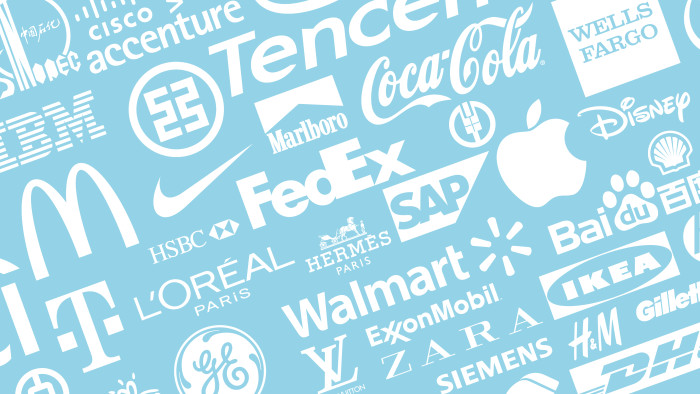How Alibaba, Tencent and JD build their brands

Simply sign up to the Retail & Consumer industry myFT Digest -- delivered directly to your inbox.
Concerned customers who purchase Australian beef on Chinese ecommerce platform JD.com can now access information about every step of the meat’s journey through the supply chain, stored on JD’s own blockchain, or digital ledger.
The innovation is an example of novel ways China’s ecommerce retailers, once stereotyped as selling cheap and shoddy goods, are evolving to meet more discerning and upscale preferences of Chinese consumers.
China’s consumer base is vast but online retailers are locked in furious competition: Alibaba’s Taobao, Taobao spin-off Tmall, Tencent’s WeChat stores and JD.com are all vying for more eyeballs and sales volume. Trust in products and reliable delivery have become key advantages as they face-off with each other for a greater stake in an online retail market worth Rmb7.18tn in sales ($1.12tn) last year alone, according to China’s commerce ministry.
At home, Chinese ecommerce platforms face a unique marketing challenge. A string of high-profile scandals over tainted food and a once-flourishing counterfeit industry have dented confidence. Unlike western reverence for brands, Chinese consumers place far more trust in endorsement from third-party influencers.
To build trust with potential buyers, individual retail brands big and small have enlisted the help of key opinion leaders (KOLs) who have taken to the myriad new mediums to attract new customers. The fees that brands pay KOLs can be staggering, running into hundreds of thousands of dollars for endorsements of under one minute.
“Chinese consumers are not loyal to one single brand,” says Daniel Zipser, senior partner at McKinsey, the consulting company. “Whatever people buy for goods or services, they will always go for the top selling item. It’s very much reliant on recommendations.”
Short video apps — platforms that allow amateur producers to shoot and share 15-30 second clips on mobile — have provided brands with a new tool to directly reach customers. More than 200 short video mobile apps now exist, according to market research consultancy Frost & Sullivan, and brands will pay popular video makers handsomely to try out their products on camera.
As they continue to develop, short video apps may one day become a potent retail force themselves, drawing sales volumes away from ecommerce giants such as Taobao and JD.com. Many of the most popular video bloggers already sell their own branded products through personal online stores.
“KOLs now are becoming the direct sales people,” says Shaun Rein, the founder of consultancy China Market Research Group. “People want to be entertained while shopping, almost like on a home shopping network, on how these stars use these products in their own life, how they wear clothes.”
Ecommerce players have taken note and invested heavily in creating the conditions for fostering meaningful interaction between buyers and sellers.
Last year, Alibaba invested substantially in bricks-and-mortar retail outfits, including a $2.6bn buyout stake to privatise Intime Retail, a Hong Kong-based department store and mall operative. The idea is for online retailers to create physical showrooms that increase brand awareness and customer engagement while providing retailers with real-time data on how to much inventory to stock.

“Last year was the first time online players very aggressively plugged into offline stores: aggressive in both investments offline players but also the changing the way that the retailer can identify consumers and convert the offline consumer into a digital consumer,” says Tianbing Zhang, head of Deloitte’s consumer and retail practice in China.
JD.com has taken a different tack and instead put effort into the last step of the online retail experience, when the delivery man hands over the parcel to the consumer.
“The JD delivery person and uniform is key to branding. I’m not sure that’s replicable in the west,” said Duncan Clark, the author of Alibaba: The House that Jack Ma Built.
Last year, JD.com launched its own standalone luxury platform, Toplife, following an earlier $397m investment in UK luxury retailer Farfetch. Customers who buy designer items from brands such as La Perla and Louis Vuitton through Toplife receive a knock at their door from white glove-wearing male couriers bearing their new purchases as a personalised delivery touch.
“You will find the couriers are often quite good looking,” says Belinda Chen, general manager of JD.com’s watch division, with a giggle.
The rise in on-demand services has also set delivery standards very high, with customers expecting their goods to arrive at their door within days. That has pushed ecommerce platforms to invest substantially in logistics networks and warehouse automation.
In February, JD.com raised $2.5bn for its logistics subsidiary and runs its own fleet of last-mile delivery teams and warehouses. In 2013, Alibaba formed its own logistics consortium called Cainiao with several of the country’s largest last-mile delivery companies. Cainiao currently processes around 100m packages a day.
The nimbleness of Chinese logistics networks has allowed Tmall and JD.com to branch into on-demand grocery delivery, with same-hour delivery often arriving within an hour of orders being placed.
Logistics on the scale of China generates a huge amount of data about who is buying what, where. That allows ecommerce players to create regional consumer profiles that can guide which inventory to stock depending on historical aggregated preferences. JD.com partners with Tencent to analyse user demographics and buying history to suggest future purchases through in-app advertisements.
“You have to end-to-end experience to have a better chance to make it more efficient,” says Chen Zhang, JD.com’s chief technology officer.

Top 100 global brands: 2018
Explore this year’s interactive BrandZ ranking of the world’s 100 most valuable brands, compiled by Kantar Millward Brown, part of the WPP advertising group
Comments